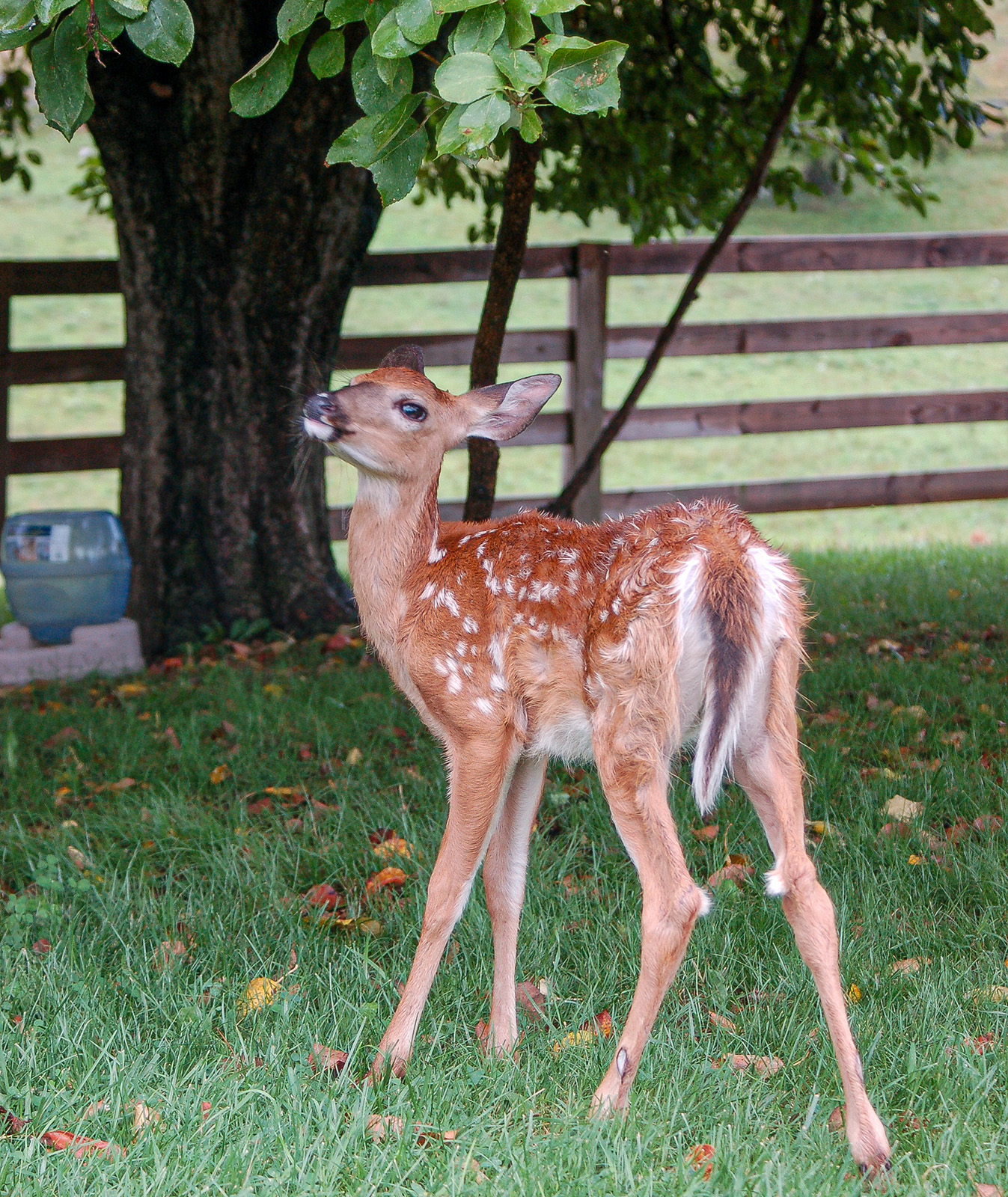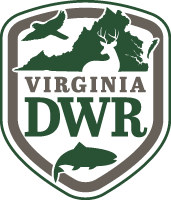By Bruce Ingram for Whitetail Times
Strong fawn recruitment plays a major role in deer management. We can assist by working in late winter and early spring to create new habitat for thick cover to help guard against predators that prey on newborn fawns!
One of the most important acts land managers can undertake is to create more habitat where does can have, hide, and feed their fawns. “The late winter and early spring period is an excellent time to create habitat to benefit fawn survival,” said Katie Martin, the deer, bear, and turkey biologist for the Virginia Department of Wildlife Resources (DWR), said. “One, the weather is often perfect to do so, often not too hot or cold. Second, the landscape is barren so that people can better envision what they’re wanting to accomplish.”
Martin said that in the Old Dominion, a two-week period exists where the majority of does drop their offspring the first fortnight in June. There can be some variation from east to west with the east seeing fawns hit the ground earlier in May, while in the west, fawning occurs primarily during the month of June. But as a whole, the majority of fawns are born in early June, which coincides to about 200 days after mid-November when bucks impregnate most does.
So new habitat created in late winter/early spring should prove to be quite lush by the birthing season.
Where to Create Cover
Ideal fawn cover should possess several features.
“To create this cover, hunters should seek out the most remote places on the land they own, lease, or have permission to hunt on and make improvements,” Martin continued. “In other words, avoid places near homes, roads, trails, and commonly used areas.” If you already have places that offer denser cover than surrounding areas, then hunters can look to make those places even thicker.
Another consideration is that food [in the form of browse] either already exists in that area or can be easily created when hunters perform habitat work. Ideally, a doe and her fawn or fawns shouldn’t have to travel far to find food or water. For example, an isolated summer thicket with blackberries, other soft mast, forbs, and perhaps a water source like a spring or creek would be close to ideal. Early in a fawn’s life (the first two weeks) the doe will leave the fawn tucked in secure cover while she forages away from the fawn. This is another survival technique to reduce scent and interaction near the fawn while it’s at its most vulnerable. Having thick cover available then for the doe to conceal a fawn is critical for its survival.

Fawns out and about in open areas, as is the case here, are not likely to survive unless thick cover lies nearby.
Benefits of Better Fawning Habitat
Of course, creating better fawning habitat often means higher fawn survival, as predators such as bears, bobcats, coyotes, foxes, feral dogs, and many others will likely find it harder to locate and kill their prey. Fawn survival is understandably lower when a property’s woodlot lacks young forest and is composed mostly of mature hardwood, mixed hardwood, and/or pine stands.
For example, in Botetourt County where I live, a property that I used to deer hunt now has an absentee landowner who has not lived there or initiated habitat improvement projects in years. Basically, the parcel consists of open forests and open fields. Making the situation worse is the fact that the land borders a section of the Jefferson National Forest where no habitat work has taken place for decades. Deer sightings are not common.
“Poor habitat is not likely to ever have high fawn survival rates,” Martin said.
The Effect of Predators on Fawn Survival
But it is simply not true that bears, bobcats, and coyotes are decimating Virginia’s whitetail herd or that this trio’s numbers are ever-increasing.
“We have no data to support the assumption that coyotes are having any impact on overall deer numbers in Virginia,” Martin said. “There are very few places in Virginia that have very low numbers of deer. Low deer numbers in these areas are primarily driven by habitat conditions. While predators can potentially have an impact on a localized area (a single property, for example) thus far across the state or individual counties, we have not seen predators cause declines in deer population numbers.
“Across the state when fawns are being born, there are so many being dropped at the same time that predators simply can’t eat large numbers of them. And as fawns grow older and become more mobile, it’s simply not energy-efficient for a coyote, bobcat, or bear to go chasing after a doe and her fawn for long distances. For coyotes especially, it’s much easier to fill up on rabbits, mice, and groundhogs, which are so much easier to catch.”
DWR Deer Project Leader Justin Folks agreed with Martin. He said that when working as a private lands biologist and meeting folks about improving their wildlife habitat, he often visited properties that hosted excellent numbers of deer but that were also “overrun” with coyotes.
“Really productive deer habitat is also good coyote habitat; the thing is, the coyotes have a lot of other food items to munch on that are easier to find than deer, just like Katie mentioned,” Folks said.
What the Data Shows
In the Summer 2023 issue of Whitetail Times, Garrett Clevinger reported the results of the Virginia Appalachian Deer Study (VADS) in Bath County. The study concluded that black bear predation was the leading cause of all fawn mortality (48 percent) within the VADS. Interestingly, the second leading cause was the generic “Other,” as in disease and doe abandonment. Bobcat and coyote predation were third and fourth, respectively, and far behind. A key conclusion of the study’s population model was that after a long period of low whitetail numbers, the deer population appears to be increasing even in the face of predation.
Another conclusion that given the goal of increasing the county’s deer numbers, the best ways to do so was “maintaining low adult female harvest and enacting active habitat management” like the kind this article describes. So even in Bath County, the deer’s number one predator—the black bear—is not keeping the deer population from increasing.
“When you look at Virginia as a whole, bears occur in higher densities primarily west of the Blue Ridge and in counties adjacent to the Blue Ridge,” she said. “These areas have historically had bears even when the rest of the state had seen bears extirpated from the landscape. Over the last 10 years, bear populations have increased east of the Blue Ridge, particularly throughout the southern Piedmont.”
Martin added that this happening was in accordance with the 2011-2021 DWR Black Bear Management Plan. The latest version of the plan (which came out in fall 2023) has proposed stabilizing populations across the majority of the state, while calling for decreasing populations in a small area of Southwest Virginia. Due to these new objectives, the bear firearms season was extended across much of the Piedmont for the 2023 season.
During this same 10-year timeframe, population growth rates for bears west of the Blue Ridge have decreased, which was also an objective of the last plan. The Northern Mountains (Shenandoah Valley and Alleghany Highlands) have seen recent declines in growth rates with lower harvest rates. Regulation changes in recent years increased opportunity for female bear harvest in these areas, which in conjunction with other factors such as sarcoptic mange and variable mast crops, led to decreases in the populations.
Due to meeting the proposed population objectives in these areas, the three-day early bear harvest season will be removed from many counties throughout the Northern Mountain area. The biologist also offers relevant information on the deer-bear population dynamic in the George Washington and Jefferson National Forest.
“The national forest still has lower deer numbers than those found on private land, but not because of bears overly preying on them,” Martin said. “There is just not enough good habitat on western public lands to draw and keep deer throughout the year. I know it’s frustrating for people to go to public land and try to successfully hunt deer. The odds of seeing a deer are slim in some places, but it’s not because of bears. It’s because of poor habitat.”
Furthermore, Martin emphasized that areas where DWR is seeing an increase in bear numbers, the whitetail numbers are not decreasing. While bear densities have increased across the Piedmont region, whitetail densities have not changed due to a new predator on the landscape, even in areas where the deer plan objective is to decrease deer densities.
Another interesting aspect of the VADS results is that bobcats proved to be more effective at killing fawns than coyotes, although the difference and sample sizes were too small to make big inferences. Martin says that in DWR annual surveys (bowhunter survey and trapper survey), hunters indicate that they are seeing far more song dogs than wildcats. Bobcat sightings have remained fairly stable (around 0.2 seen per 100 hours afield for the past 10 years) while coyote sightings average around 0.8 per 100 hours statewide, but generally trend slightly higher west of the Blue Ridge.
Bobcats tend to have more cyclic population trends following the booms and busts of their primary prey sources (rabbits and rodents). Does that mean that bobcats are more effective deer predators than coyotes? DWR has no data one way or the other concerning that supposition.
Specific Habitat Projects to Create Fawning Cover
Bob Boeren, who operates Boeren’s Forestry Consulting, related that land managers can conduct a number of activities to improve summer fawn sanctuaries.
“Certainly, one of the best timber stand improvement projects [TSI] is hinge cutting,” he says. “It creates dense, brushy growth right on the ground. If you hinge cut several trees in a small area, so much the better. And if you cut the right kind of trees, then you’re providing browse and cover for a doe and her fawns at the same time.”
The Botetourt County resident explained that red maples and redbuds are two examples of common Virginia trees that deliver both cover and browse. Another common state tree, the red cedar, excels at rendering cover when hinge cut. Boeren suggests that important hard and soft mast producers (such as white and red oaks as well as dogwoods and persimmons) not be levelled because of their food value.
“When hinge cutting, select trees that are fairly small… no more than five or six inches in diameter,” the forester continued. “Make the cut no more than halfway through the tree, then bend it over. You want a substantial part of the tree’s cambium to still be receiving nourishment.”

Hinge cutting, as shown here, offers land managers the chance to create more ground cover and undergrowth…definitely good for fawns when predators are on the prowl!
Boeren said another goal should be to allow more sunlight to reach the ground so that forbs and summertime berry producers (think native raspberries, blackberries, and northern dewberries) can form a dense carpet. If a tree such as red maple, poplar, or sycamore, for example, does not lend itself to hinge cutting, then perform the hack and squirt maneuver. Use an axe or tomahawk to carve out a half dozen or so “cups” around a tree, then fill up those cups with a triclopyr-based product.
Girdling, added Boeren, also can work well in killing a standing tree. Use a chainsaw to create two or three parallel slices through the bark. The tree should die in a year or two; meanwhile more sunlight will be setting free the soil’s seed bank. Of course, a downside exists to these TSI activities.
“More forbs and berry vines will be rising up, but it’s also very likely that daylighting the forest floor will also cause invasive plants to spring up,” he said. “Autumn olive, multiflora rose, sericea lespedeza, bush honeysuckle, and stilt grass are just a few of the many invasive plants that can cause problems.”
Boeren recommends a triclopr-based compound for woody growth such as autumn olive, multiflora rose, and bush honeysuckle and a glyphosate compound for grassy invasive plants such as sericea lespedeza and stilt grass. Finally, Boeren suggested planting native warm season grasses, such as switchgrass, in areas that border fawn sanctuaries. Although they won’t provide valuable cover this summer, they certainly have the potential to do so in the coming years.
Creating better cover this late winter/early spring can result in higher fawn survival this summer. So, fire up the chainsaw, fill up your squirt bottles, and prepare for some very satisfying outdoor labor.
Bruce Ingram, staff writer for Whitetail Times, lives in Fincastle, Virginia with his family. Ingram is a serious whitetail hunter and fisherman. His hunting and fishing articles have been published in state, regional and national publications.
©Virginia Deer Hunters Association. For attribution information and reprint rights, contact Denny Quaiff, Executive Director, VDHA.



